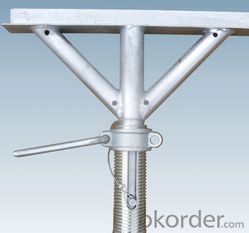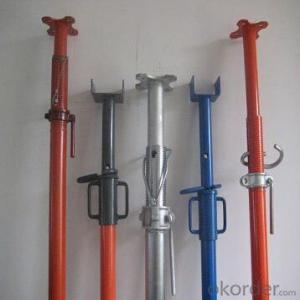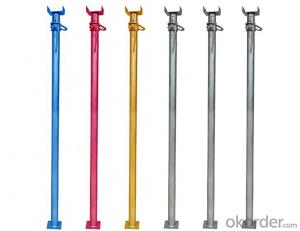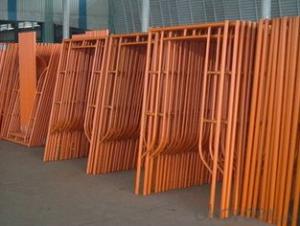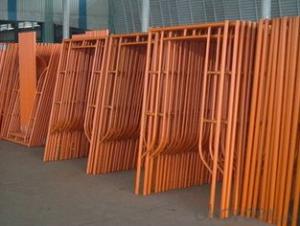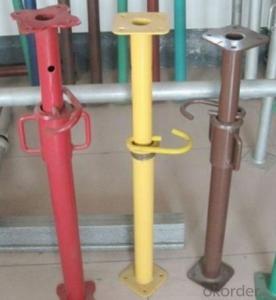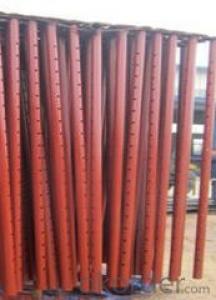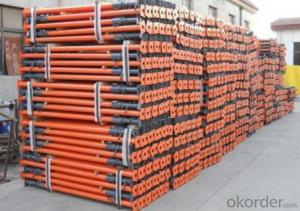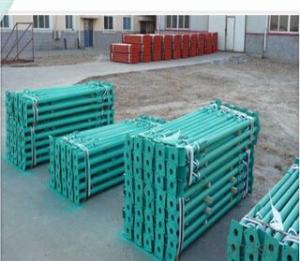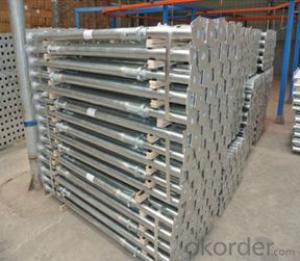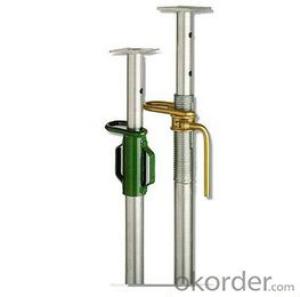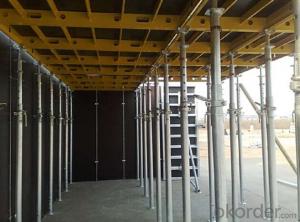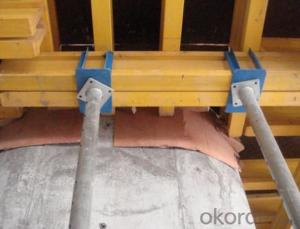Adjustable Strong Steel Prop For Sale scaffolding
- Loading Port:
- Tianjin
- Payment Terms:
- TT OR LC
- Min Order Qty:
- 10000 PCS
- Supply Capability:
- 10000 PCS/month
OKorder Service Pledge
OKorder Financial Service
You Might Also Like
Quick Details
| Model Number: | 48mm*2mm/60mm*2mm | ||||
| material: | Q235 | color: | oranger/blue/red | Surface treatment: | painted, galvanized, powder coated |
| Length: | 2000-4000mm | Main Thickness: | 2.0mm | Life Span: | about 5 years |
Packaging & Delivery
| Packaging Detail: | nil |
| Delivery Detail: | 10 days after deposit |
Specifications
1.surface treatment :galvanized/painted
2.outer tube dia:60mm,thickness:2.0mm
3.inter tube dia:48mm:thickness:2.0mm
1. A complete set of steel prop consists of an inner tube, an outer tube, a prop nut, a Jack plate and a Base plate.
2. This kind of steel props is easy to assemble and dismantle; it can be adjusted to any length within its range.
3.When the steel props are used for inside concrete slab supporting, it is more stable and reliable.
4. We can produce different kinds of steel props as the customer’s requirement which can save you much time and material at the same time.
5. Specifications about steel prop
Spanish Type Prop
Inner Tube Diameter | 48mm |
Outer Tube Diameter | 58mm |
Adjustable Length | 2000mm~3500mm |
2500mm~4000mm | |
3000mm~4500mm | |
3500mm~5000mm | |
Tube Thickness | 1.8mm/2.0mm/2.2mm |
- Q: What are the potential risks or hazards associated with using steel props?
- There are several potential risks or hazards associated with using steel props in construction or other applications. Firstly, steel props may not be suitable for all types of loads or applications. If the load exceeds the capacity or design limits of the props, they may fail or collapse, leading to accidents, injuries, or property damage. Secondly, steel props rely on proper installation and positioning to be effective and safe. If not properly installed, the props may not provide adequate support and stability, leading to structural instability or collapse. Additionally, if the props are not positioned correctly, they may create uneven or unbalanced loads, which can also compromise the stability of the structure. Another potential risk is associated with the use of damaged or worn-out steel props. Over time, props may become corroded, weakened, or damaged due to various factors such as exposure to harsh weather conditions or mishandling. Using damaged or worn-out props can significantly increase the risk of structural failure or collapse. Furthermore, steel props can pose risks during the assembly and dismantling process. If not done carefully and according to proper procedures, workers may be at risk of being struck by falling props or other materials. Additionally, mishandling or improper storage of steel props can lead to injuries from cuts, bruises, or strains. Lastly, steel props may also pose risks related to their weight and size. They can be heavy and difficult to handle, especially in confined spaces or when working at heights. Improper lifting techniques or inadequate training can lead to accidents, injuries, or strains. To mitigate these risks, it is crucial to ensure that steel props are used within their design limits, properly installed and positioned, regularly inspected for damage, and replaced when necessary. Adequate training and supervision should be provided to workers involved in the assembly, dismantling, and handling of steel props. Additionally, workers should use appropriate personal protective equipment and follow safe work practices to minimize the potential hazards associated with using steel props.
- Q: What is a steel prop?
- A steel prop, also known as an adjustable steel prop or an acrow prop, is a temporary support device commonly used in construction and renovation projects. It consists of a telescopic steel tube with an adjustable length and a base plate at the bottom. The purpose of a steel prop is to provide temporary support or reinforcement to structures, such as walls, beams, or ceilings, during construction, repair, or alteration work. The adjustable feature of a steel prop allows it to be extended or retracted to the desired height, making it suitable for various applications and different ceiling or wall heights. The base plate at the bottom provides stability and prevents the prop from sinking into the ground or damaging the surface it is placed on. Steel props are primarily used to transfer the load from the structure being worked on to the ground, ensuring safety and stability. They are commonly used in situations where traditional permanent supports, such as columns or walls, are not feasible or practical. Steel props are lightweight, easy to handle and transport, and can be quickly installed or removed, making them a cost-effective solution for temporary support needs. In conclusion, a steel prop is a versatile and adjustable support device used in construction and renovation projects to provide temporary reinforcement and stability to structures. Its adjustable height and portable nature make it a popular choice for various applications, ensuring safety and facilitating construction work.
- Q: How do you ensure the stability of a steel prop on uneven terrain?
- To ensure the stability of a steel prop on uneven terrain, it is essential to take a few measures. First, selecting a prop with adjustable height capability is crucial. This feature allows for precise adjustment to match the varying levels of uneven terrain. Additionally, using a base plate or footplate with a wide surface area can distribute the weight of the prop more evenly, minimizing the risk of sinking into the ground. It is also important to position the prop perpendicular to the ground and ensure it is securely locked in place. Lastly, regularly inspecting the prop and surrounding terrain for any signs of instability or shifting is vital to maintain a safe and stable working environment.
- Q: Are steel props adjustable in both horizontal and lateral directions?
- Steel props are known for their adjustable features, both horizontally and laterally. They are commonly used in construction to stabilize and support structures. These props are equipped with a threaded mechanism that allows for easy height adjustment, making them suitable for various construction applications. When it comes to adjusting the prop in horizontal and lateral directions, they usually have swivel heads or base plates. The swivel head feature enables horizontal adjustment, accommodating different angles and positions. Additionally, the base plate can be adjusted laterally to provide stability and support in different directions. The ability to adjust steel props in both horizontal and lateral directions is crucial in construction. It ensures precise positioning and alignment to effectively support the load-bearing structure. This adjustability allows the props to adapt to different construction scenarios and provide optimal stability and support. It's important to note that the adjustability of steel props may vary depending on their design and manufacturer. To ensure adjustability in both horizontal and lateral directions, it is recommended to refer to the manufacturer's instructions or specifications for each specific steel prop.
- Q: Are steel props suitable for supporting temporary bridges?
- Indeed, steel props prove to be a fitting choice when it comes to supporting temporary bridges. In construction, these steel props, also referred to as steel shores or steel jacks, are widely employed to provide support for temporary structures such as bridges. With their robustness, durability, and ability to bear substantial loads, steel props emerge as the perfect option to offer temporary support for bridges during construction or repair tasks. The ease of adjustment and secure placement of steel props ensure stability and safety for the temporary bridge. Furthermore, the height and load capacity of steel props can be tailored to meet the specific requirements of the bridge. In summary, steel props stand as a dependable and efficient solution for supporting temporary bridges.
- Q: What are the factors to consider when selecting the right steel prop?
- When selecting the right steel prop, there are several factors that need to be considered: 1. Load capacity: The first factor to consider is the load capacity of the steel prop. It is important to determine the maximum load that the prop will need to support. This will ensure that the prop is able to withstand the weight and provide adequate support. 2. Height adjustment: Another important factor is the height adjustment range of the steel prop. It is crucial to choose a prop that can be adjusted to the desired height. This will allow for flexibility in different construction scenarios. 3. Stability and durability: The stability and durability of the steel prop are also important factors to consider. The prop should be able to withstand external forces and provide a stable support system. It should also be durable enough to withstand repeated use without getting damaged. 4. Ease of use: The ease of use is another factor that should be taken into account. The steel prop should be easy to set up, adjust, and dismantle. It should have user-friendly features that make it convenient to use. 5. Safety features: Safety is paramount in any construction project. Therefore, it is crucial to select a steel prop that comes with appropriate safety features. This may include anti-slip surfaces, locking mechanisms, and safety pins to prevent accidental collapses. 6. Compatibility: Compatibility with other construction equipment is also an important factor. The steel prop should be compatible with other scaffolding systems or support structures that will be used on the construction site. 7. Cost-effectiveness: Finally, the cost-effectiveness of the steel prop should be considered. It is important to choose a prop that offers a good balance between quality and price. While it may be tempting to opt for the cheapest option, it is crucial to ensure that the prop meets the necessary safety and performance standards. Considering these factors will help in selecting the right steel prop that meets the specific requirements of the construction project, ensuring safety, stability, and efficiency.
- Q: Are there any specific regulations or standards that govern the use of steel props?
- Yes, there are specific regulations and standards that govern the use of steel props. These regulations and standards are in place to ensure the safety and structural integrity of structures being supported by steel props. In many countries, the use of steel props is covered by building codes and regulations that dictate the minimum requirements for their design, installation, and usage. For example, in the United States, the Occupational Safety and Health Administration (OSHA) provides regulations and guidelines under the Construction Industry Safety and Health Standards (29 CFR 1926) that address the use of steel props as temporary supports. These regulations outline requirements for the design, installation, inspection, and removal of steel props to prevent accidents and protect workers. Furthermore, various organizations and standards bodies have developed specific standards and guidelines for the use of steel props. One such example is the British Standard BS 4074, which provides guidelines for the design, construction, and use of adjustable steel props in temporary support structures. These regulations and standards typically cover aspects such as load capacities, maximum heights, spacing requirements, bracing, stability, and safe working practices. They also often require proper documentation, including instructions for use, maintenance records, and regular inspections. It is essential for construction professionals, contractors, and workers involved in the use of steel props to be familiar with these regulations and standards and ensure compliance to ensure the safety of personnel and the structural stability of supported structures.
- Q: How do you ensure proper stability during seismic activities when using steel props?
- Proper stability during seismic activities when using steel props can be ensured by taking several measures. Firstly, it is important to use high-quality steel props that are designed and manufactured to withstand seismic forces. These props should be properly sized and installed, considering the anticipated loads and ground conditions. Secondly, the props should be securely anchored to the ground or structure to prevent any movement or displacement during seismic events. This can be achieved by using appropriate anchoring systems such as concrete footings, ground anchors, or specialized seismic bracing. Furthermore, regular inspections and maintenance of the steel props are crucial to identify any signs of damage or wear that could compromise their stability. Any detected issues should be promptly addressed and necessary repairs or replacements should be carried out. Lastly, it is essential to follow local building codes and regulations related to seismic design and construction to ensure that the steel props are installed and used in compliance with the recommended guidelines and standards. This may involve consulting with structural engineers or seismic experts to assess the specific requirements and implement appropriate measures for stability during seismic activities.
- Q: Can steel props be used for temporary support during roofing work?
- Yes, steel props can be used for temporary support during roofing work. Steel props provide strong and sturdy support, making them suitable for temporarily holding up roofing structures and ensuring the safety of workers and the integrity of the roof.
- Q: How do steel props compare to screw jacks in terms of stability?
- During construction activities, temporary support can be provided by using steel props or screw jacks. When it comes to stability, both steel props and screw jacks have their own advantages and limitations. Steel props, which are also referred to as adjustable props or acrow props, are typically constructed using steel tubes with a threaded end and a removable pin. Their main purpose is to support vertical loads and provide stability to structures during construction. The robust construction of steel props allows them to offer excellent stability and withstand heavy loads. They are especially suitable for supporting larger structures or heavy loads, as their load-bearing capacity is higher compared to screw jacks. On the other hand, screw jacks consist of a threaded rod and a large plate that rests on the ground or a suitable base. They are commonly used for leveling or supporting smaller structures. The height of the rod can be adjusted in order to provide stability and precise leveling or support. While screw jacks are generally stable, their load-bearing capacity is lower compared to steel props. They are typically used for lighter loads or situations where precise adjustments are required. To summarize, both steel props and screw jacks offer stability, but their suitability depends on the specific requirements of the construction project. Steel props are more appropriate for supporting larger structures or heavier loads, while screw jacks are often used for smaller structures or situations that require precise adjustments. When choosing between steel props and screw jacks, it is important to consider the load requirements, the size of the structure, and the desired level of stability.
Send your message to us
Adjustable Strong Steel Prop For Sale scaffolding
- Loading Port:
- Tianjin
- Payment Terms:
- TT OR LC
- Min Order Qty:
- 10000 PCS
- Supply Capability:
- 10000 PCS/month
OKorder Service Pledge
OKorder Financial Service
Similar products
Hot products
Hot Searches
Related keywords

